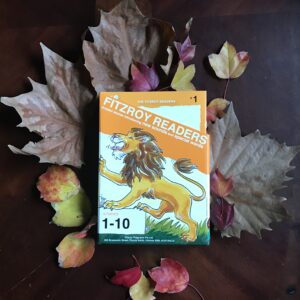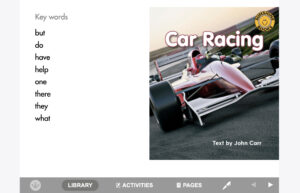Literacy learning levels post-pandemic

Literacy trends are observed with great interest and many in the education sector are keen to understand how the global pandemic and its associated lockdowns have impacted on literacy learning amongst our young.
The full Term 4 issue is now available to view online here.
The recently released summary of this year’s National Assessment Program for Literacy and Numeracy shows Year 3, 5, 7 and 9 students continued to produce literacy results similar to those recorded by students in 2019, despite having experienced several lockdowns during 2020.
The 2021 NAPLAN tests, on which the summary data is based, took place in May, before the Delta outbreak in Australia led to school closures and remote learning resuming in New South Wales and Victoria. These tests were cancelled in 2020 due to the pandemic, so no equivalent data exists for last year.
Year 3 and 5 results have seen a steady upward trend in reading and Year 5,7 and 9 have seen a steady upward trend in numeracy, resulting in total gains–equivalent to at least 3 months of learning. The ongoing downward trend in writing in Year 5, 7 and 9 has begun to reverse, flattening, and showing signs of an upward trend.
“These results will be welcomed by governments, schools, parents and carers as a first national insight into the educational impact of the pandemic,” said Australian Curriculum Assessment and Reporting Authority CEO, David de Carvalho.
“It’s reassuring to see that overall, our students’ literacy and numeracy standards have not significantly suffered, despite the major disruptions of COVID-19 and remote learning. However, this does not mean there has been no impact on specific students or demographic groups.”
The overall impact of lockdowns on children’s education is unknown, with many factors influencing at home learning, but these preliminary figures demonstrate that, in the main, it’s good news in terms of literacy standards.
“Generally, the average trend is positive, with improvements for Year 3 and 5 reading and Year 5, 7 and 9 numeracy showing gains equivalent to a term’s worth of learning since the base year,” says de Carvalho. He is also pleased with the signs that writing standards, which had previously been in gradual decline, appear to be levelling out, or better.
“The overall decline in writing has begun to flatten, and achievement in Year 5, 7 and 9 has begun to reverse and show signs of an upward trend.
“The results suggest that persistent effort to improve outcomes pays off,” he said. “It is testament to the resilience of students, teachers, parents and carers, and school and system leaders during these challenging times.”
NAPLAN testing has moved largely online over the past year – a total of 70 percent of schools delivered the tests online in 2021.
Investigating trending tools for literacy education, we sought key industry perspectives.

Dr Jennifer Buckingham, Director of Strategy and Senior Research Fellow at MultiLit advised that “while the research literature on teaching literacy is growing at a rapid pace, it is remarkably consistent”.
“The scientific consensus for the past several decades at least has been that beginning readers need explicit and systematic instruction in the letter-sound relationships that allow them to ‘decode’ words when learning to read, and that this should be embedded in a varied and rich program of language development, including children’s literature. This creates the virtuous cycle of becoming successful at reading, which leads to greater enjoyment of reading, which leads to more and better reading. Children will engage with literacy when they feel successful and supported. Explicit instruction is all about creating the conditions for success.
“There is an enormous demand for professional learning on evidence-based approaches to teaching literacy. Since I launched the Five from Five project (a free online resource for teachers and parents) in 2016, the interest among teachers has grown to the point that thousands of teachers attend professional learning events in their own time every month. I am professionally and personally driven to give teachers access to information that will help them to do what is arguably the most fundamental purpose of schools: teaching children to read.”
Dr Buckingham’s dos and don’ts for teaching learners of varied ability level:
“Do: Provide a programme of systematic and explicit instruction in the five ‘keys’ to reading for all children from the first weeks of school. Early screening assessments are useful but are not fool proof in identifying students who might have difficulty learning to read, so the best approach is to provide the highest quality instruction to all children, leaving nothing to chance.
“Do: Use appropriate assessments to monitor students’ reading progress and respond accordingly.
“Do: Make sure that children get lots of reading practice on the right texts for their age and stage of reading development. Decodable texts rather than predictable texts are best for beginning readers. Once they crack the code, their independent reading will expand to include all kinds of age-appropriate books.
“Don’t: Assume students who are having difficulty with reading will catch up or ‘get it’. Early intervention is best but it’s never too late to help a struggling reader.”

Debbie Esquilant, Manager, Learning A-Z and Kurzweil Education, at IG3 Education told us:
“Teaching resources that empower the teacher to have a greater impact on a student’s learning by providing a collection of flexible curriculum resources aligned to research based best practices and being able to personalise instruction are trending within the industry now.
“It is crucial for programmes to support a broader range of students needs and learning styles, there are many ways in which schools and teachers are achieving this.
“Digital literacy tools using adaptive learning is having a large impact on education, especially for students who require additional support and for classrooms where teachers are teaching learners with varied abilities or levels, the benefits of AI in education have been highlighted over the past two years because of the pandemic and schools moving towards an online remote learning model. AI is providing teachers with the ability to provide their students with resources that can be adapted to the individual student’s needs, ensuring that one on one support to a student either through the initial testing stages or from the program’s ability to respond to a student’s needs creating an individualised learning plan focusing on those concepts in learning that the student is lacking in and working with the student to ensure they are provided with the right learning materials to enhance their learning.
“Blended learning allows schools to not only focus on literacy but also on other important areas such as social emotional learning, which has been shown to increase academic achievement, greater understanding of themselves and their peers and reduce a student’s emotional stress.
“In a classroom environment when all students are learning at the same level and pace teachers have experienced that gifted students can easily get bored and struggling students are being left behind, with blended learning instruction remains effective throughout the entire learning process therefore setting students up for success.”

Philip O’Carroll, co-founder and editor at Fitzroy Readers, emphasised the importance of personalising the learning process:
“We encourage teachers to use a variety of activities to get first-year students acquainted with letters and how they sound. The most effective approach is for a literacy programme provider to regularly correspond with teachers or chat over the phone to recommend relevant materials and build a resourceful working relationship over time.
“In literacy, logical sequencing is the key. There is no gain in leaping to a new activity when the students are not familiar with the fundamentals underlying the activity. For example, I recommend introducing one or two letters at a time and inviting the children to connect the letters to the correct drawings. Then there’s the ‘architectural’ approach. Join all the letters which match and bingo, you’ve drawn a house, or a snake, or…

“I believe strongly that it is good practice to provide some extra activities for the benefit of the children who race through primary activities and need something else to do. On the other end of the spectrum, if the little ones are getting worn out, I think it works well sometimes to choose an easy word like it (or another word they can read) and collect ideas from the children to make a story about it. They take this seriously, and when it’s all over, we can run off a copy for them to take home!”

Paul George, General Manager of Sunshine Books, acknowledged that the last two years have presented many new challenges for schools as the need to teach remotely has been ever-present and in some cases long-term. He said:
“Being able to provide the same level of quality teaching remotely has been hard for teachers and children and their families. More than ever, teachers have had to look for quality digital resources to support their students learning at home. For literacy learning, online programs that provide digital books and activities have had a big part to play to ensure that children could continue to access a wide range of books for their reading. In terms of online literacy programs, the ones that best reflect and support how teachers teach literacy in the classroom are ideal.
“A classroom literacy program starts with quality books and that is where the program needs to start. Lots of engaging levelled fiction and non-fiction texts. The beauty of digital texts is that there can be many extra elements that bring the text to life such as animations, embedded videos, narration and text highlighting. These are important features of good online literacy programs. Any interactive activities and games should relate to the text and not stand-alone. The program should also offer tracking and reporting so that teachers can see at a glance what their students have completed and their results.

“Teaching to individual needs is just as important in remote learning as it is in face-to-face teaching. Using digital tools for learning is normal for our children. There was a time that just using these tools provided an engagement factor. Now it comes down to online resources that are well constructed and engaging. Students expect digital books for example to be multi-modal with visual and textual information presented in a range of ways.”

Hannah Creelman, Primary School Teacher and Digital Education Specialist at Britannica Digital Learning, emphasised the importance of personalising the learning process:
“The best digital tools incorporate synchronous and asynchronous learning. Using digital multimedia tools like podcasts, animations and live sessions enable a variety of diverse learning styles and provide constant connection between educators and students allowing them to openly discuss, question, clarify and share collaboratively. Online learning scenarios also give teachers immense flexibility in allowing students to access the content in their own time and at their own pace.
“Good digital tools will also include reporting and assessment data so teachers can track student progress in real time. They also provide instant feedback, reinforcement and encouragement to the student.”

Hannah points out that “school tend to overlook the capacity to integrate digital literacy tools outside of the classroom. In doing so students will develop literacy skills that not only benefit them in reading and writing across all subject areas, but that strengthen their speaking abilities as well as self-efficacy enabling them to communicate effectively with confidence. Tools such as audiobooks enable students to select a genre of their choice and listen to a story being read in multiple languages. Also, author read-alouds, where authors read a book that is of high interest to the student are engaging and motivating. Implementing reading strategies that focus on enhancing reading skills, such as annotating and summarising teach students better thinking routines and support them to better dissect text, ask questions, find evidence and much more.”
Dos, Don’ts and how to boost engagement
“Digital tools themselves are engaging and exciting for learners, those that provide content across multiple formats such as text and video as well as gamification, definitely boost engagement. Gamification enables learners to learn, practice and implement their knowledge and skills while participating in a fun and exciting game.
The use of video and animations are also hugely beneficial to student learning because they make content more understandable and skill acquisition more comprehensible for the learner.
“Another method to boost engagement is through the use of virtual and augmented reality experiences, allowing students experiential learning in situations and scenarios they would not normally have access to such as walking on the moon, exploring the ancient ruins in Machu Picchu or participating in a science experiment with low-risk danger.”







